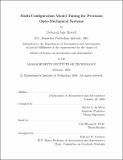| dc.contributor.advisor | Olivier L. de Weck. | en_US |
| dc.contributor.author | Howell, Deborah Jane, 1979- | en_US |
| dc.contributor.other | Massachusetts Institute of Technology. Dept. of Aeronautics and Astronautics. | en_US |
| dc.date.accessioned | 2005-05-17T14:49:46Z | |
| dc.date.available | 2005-05-17T14:49:46Z | |
| dc.date.copyright | 2004 | en_US |
| dc.date.issued | 2004 | en_US |
| dc.identifier.uri | http://hdl.handle.net/1721.1/16659 | |
| dc.description | Thesis (S.M.)--Massachusetts Institute of Technology, Dept. of Aeronautics and Astronautics, 2004. | en_US |
| dc.description | Includes bibliographical references (p. 141-146). | en_US |
| dc.description | This electronic version was submitted by the student author. The certified thesis is available in the Institute Archives and Special Collections. | en_US |
| dc.description.abstract | It is important for the design of future space-based observatories that simulation models physically represent the designed system and are able to track along configuration changes. This thesis outlines a three-step procedure for model tuning of complex opto-mechanical systems in the presence of measured experimental data. It is the hypothesis of this thesis that this procedure will produce a model that effectively tracks along configuration changes. The first step, engineering insight, applies model heuristics to the simulation model in an effort to produce a simulation model that includes all physical effects in the experiment. The next step, model updating, is an automated procedure whereby an optimization problem is formed in order to set uncertain model parameters. The final step is model tracking across configurations. Configuration changes include, but are not limited to, changes in mass, input/output locations, changes in geometric properties and relative placements. A new metric is provided which helps to gauge the level of experimental/model mismatch in the new configuration (using the updated model) by using the objective function from the optimization in Step 2. Using this metric, one can determine how the model changes with respect to specific configuration changes. Finally, this three-step tuning procedure is compared against traditional model tuning on a testbed at the MIT Space Systems Lab (SSL) in order to gauge its usefulness. The traditional model tuning will be performed by a colleague in the SSL who will use such methods as trial-and-error parameter updating to match the simulation model to the experimental data. | en_US |
| dc.description.abstract | (cont.) Using the multi-configuration metric presented in this thesis, it is shown that the model produced using the three step method does track configurations better than the model produced using traditional model tuning. | en_US |
| dc.description.statementofresponsibility | by Deborah Jane Howell. | en_US |
| dc.format.extent | 146 p. | en_US |
| dc.format.extent | 3675077 bytes | |
| dc.format.extent | 3674865 bytes | |
| dc.format.mimetype | application/pdf | |
| dc.format.mimetype | application/pdf | |
| dc.language.iso | eng | en_US |
| dc.publisher | Massachusetts Institute of Technology | en_US |
| dc.rights | M.I.T. theses are protected by copyright. They may be viewed from this source for any purpose, but reproduction or distribution in any format is prohibited without written permission. See provided URL for inquiries about permission. | en_US |
| dc.rights.uri | http://dspace.mit.edu/handle/1721.1/7582 | |
| dc.subject | Aeronautics and Astronautics. | en_US |
| dc.title | Multi-configuration model tuning for precision opto-mechanical systems | en_US |
| dc.type | Thesis | en_US |
| dc.description.degree | S.M. | en_US |
| dc.contributor.department | Massachusetts Institute of Technology. Department of Aeronautics and Astronautics | |
| dc.identifier.oclc | 56528760 | en_US |
